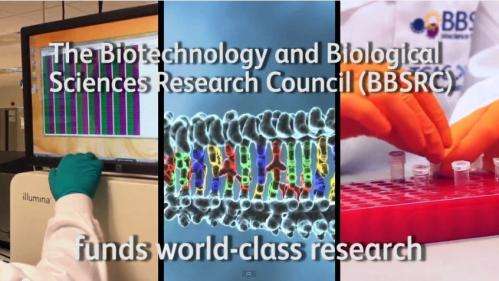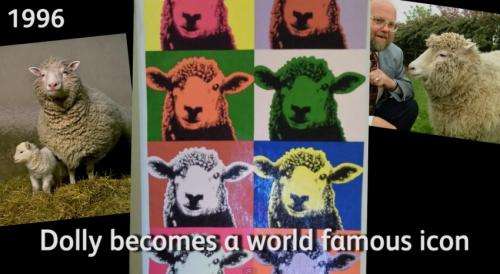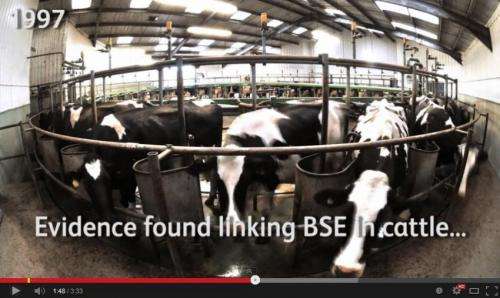Impacts of bioscience #1 (1994-1999)

Video timeline reveals benefits of research funded by BBSRC, institutes and predecessors.
The first in a series of videos presenting outcomes of BBSRC-funded science.
Part of BBSRC's 20th anniversary year, other special content includes an interactive timelinewww.bbsrc.ac.uk/upload/structu … e/img/i-external.png, interviews with great British bioscience pioneers, awards for excellence in bioscience as well as new funding opportunities for early-career researchers.
1994 – Founding
BBSRC established by merging the Agricultural and Food Research Council (AFRC) with the biotechnology and biological sciences programmes of the Science and Engineering Research Council (SERC). The move stemmed from a UK Government white paper: 'Realising our Potential'. BBSRC's mission placed 'special emphasis on meeting the needs of users of its research and training output, thereby enhancing the United Kingdom's industrial competitiveness and quality of life'.
1995 – Cereal genetics
BBSRC-funded researchers at the John Innes Centre (JIC) demonstrate the order of genes in cereal crops is remarkably similar. For instance, the location of a specific gene in rice indicates where the corresponding gene will be found in more complex genomes, such as wheat. Known as synteny, the finding has been at the heart of crop improvement ever since and worth millions to plant breeders.
1995 – Biotechnology YES
The Biotechnology Young Entrepreneurs Scheme (YES) launches to help early-career researchers develop entrepreneurial skills. To date, the competition has helped over 4,000 scientists think about commercialising their science and is organised jointly by the University of Nottingham Institute for Enterprise and Innovation (UNIEI) and BBSRC.
1995 – Deciphering DNA-protein complexes
BBSRC's first Chairman Sir Tom Blundell did much work on the definition of the architectures of complex multi-protein assemblies involved in cell signalling and regulation, and DNA repair signalling. This work helped to develop a fundamental understanding of how proteins interact with DNA, a fundamental aspect of how cells grow, divide and die, which has major applications in healthy living and drug discovery.
1995 – Harnessing bacteria
Kosan Biosciences founded in 1995 to exploit patents arising from research started at JIC and continued at Stanford University. The company aimed to exploit the newly invented field of combinatorial biosynthesis to produce novel antimicrobials and anti-cancer drugs. In 2006, at its peak as a public company, Kosan had 130 employees in California. Kosan was bought by Bristol Myers Squibb for US$190 million in May 2008.
1996 – Dolly the sheep
BBSRC-funded researchers at The Roslin Institute create Dolly the sheep, the first mammal to be cloned from an adult body cell.
Dolly was created using the technique of somatic cell nuclear transfer, where the nucleus from an adult cell is transferred into an unfertilised developing egg cell that has had its nucleus removed. She went on to become the world's most famous sheep.

1996 – Complex microbe sequenced
The genome of baker's yeast, Saccharomyces cerevisiae, is sequenced by an international consortium including BBSRC-funded scientists.
This was a major milestone in genomics science, being the first eukaryote (an organism whose cells contain a nucleus that carries the genetic material) to have the entirety of its genetic information sequenced.
1996 – First GM food on sale in the UK
A tomato puree becomes the first genetically engineered food on sale in the UK. The tomatoes, which are engineered to soften and deteriorate more slowly than other tomatoes, were developed through BBSRC-funded research at The University of Nottingham.
1997 – Heart-healthy oatmeal
Research at the BBSRC-funded Institute of Food Research on the effect of oat beta-glucan on the physical properties of the gut contents provided evidence that Quaker oatmeal was heart-healthy.
This was the first food-specific health claim to be approved by the US Food and Drug Administration (FDA).
1997 – Cattle BSE linked to human CJD
Research at the BBSRC-funded Institute for Animal Health (now The Pirbright Institute) provides evidence linking bovine spongiform encephalopathy (BSE) in cattle and the human disease 'new variant' Creutzfeldt–Jakob disease (vCJD).The discovery followed nearly a decade of research on BSE and related diseases at the Institute, which in turn built on a legacy of scrapie research supported by BBSRC and its predecessors going back to the 1950s at various institutes and universities.
1998 – Structural biology centres
BBSRC reviews UK structural biology and establishes six centres to ensure continued cutting-edge research and to provide access to structural biology for the bioscience research community.
The centres help determine, analyse and exploit the structure of proteins and other molecules, contributing powerful insights into biological function.
1998 – 'Green Revolution' gene

Scientists at JIC identify the Rht gene, boosting our understanding of how plant height is controlled by hormones and the 'Green Revolution' increases in yield resulting from the introduction of new varieties of wheat and rice. Dwarf wheat varieties continue to dominate UK wheat production and are worth around £75M to the UK economy each year.
1998 – Pyrethroids fight malaria
The synthetic pyrethroid insecticides were developed at Rothamsted Research, which receives strategic funding from BBSRC, in the 1960s and 1970s. Today they account for around one sixth of global insecticide sales, and global annual sales of pyrethroids exceed US$1.4Bn. A pyrethroids timeline reveals that they are also used to impregnate anti-mosquito bed nets, which in 1998 was made a key part of the WHO's Roll Back Malaria campaign and strategy to control the disease that still kills millions each year.
1998 – Structure of bluetongue virus core determined
BBSRC-funded researchers are involved in determining the structure of the core particle of the bluetongue virus. This is the largest molecular structure to be determined in such detail. Bluetongue virus causes a devastating disease of ruminants such as sheep, goats and cattle and is spread by biting midges.
1998 – Solexa sequencing founded
Based on BBSRC funding, Professor Balasubramanian and colleagues from the University of Cambridge found Solexa Ltd., a company to commercialise their 'Solexa' sequencing technique that improved cost efficiency and speed by 1,000 to 10,000 fold on previous technologies. The company is later bought by Illumina for US$600M. He later wins BBSRC's Innovator of the Year 2010.
1999 – National collections
The UK National Culture Collection (UKNCC), established under the aegis of BBSRC, goes online April 1999. To improve access for industrial and academic researchers to the ten separate collections of micro-organisms and cells that comprise the UKNCC.
1999 – Gene silencing
Professors Sir David Baulcombe and Andrew Hamilton, funded by BBSRC, identify short RNA molecules as the agents which enable cells to prevent the expression of a certain gene.
This 'gene silencing' has wide-ranging application in crop improvement as well as in human medicine. Gene silencing techniques have also been widely used by researchers to study genes associated with disorders such as cancer, infectious diseases, respiratory diseases and neurodegenerative disorders.
More information:
Arran Frood
Digital Content Producer, BBSRC
arran.frood@bbsrc.ac.uk
Provided by Biotechnology and Biological Sciences Research Council